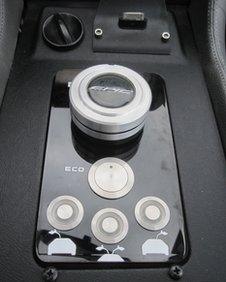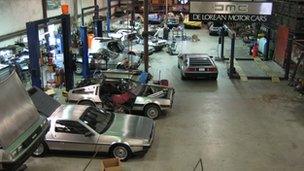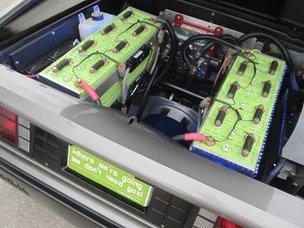Back to the future as DeLorean goes electric
- Published
The DeLorean Motor Company headquarters in Houston, Texas is something of a Mecca to owners of the DMC-12.
In the reception, glass cabinets are packed with paraphernalia from the original DeLorean factory in Dunmurry, Northern Ireland.

The DeLorean's gull-wing doors still have the power to impress
On the wall, there is an original DMC-12 door panel, covered in a roughly scrawled note. It reads: "This is the last right hand door to be made at DMC… The end of a dream. Or is it?"
Prophetic words perhaps, because after nearly 30 years since the factory closed, the DeLorean is about to be given a new lease of life as an electric car.
Due to hit the market in early 2013, the company says the DMC-EV will cost $90,000 (£57,000) and is aiming for a first production run of 300 vehicles.
Stephen Wynne is the Liverpool-born chief executive of the DeLorean Motor Company. He moved to the US 30 years ago to work as a mechanic and began specialising in DMC-12s.
The car soon became a household name following its appearance as a time machine in the 1985 film Back to the Future.
After rising to become the most prominent businessman dealing in the car, Mr Wynne bought the rights to the DeLorean brand in 1995.
Since then, Mr Wynne's company has been offering maintenance and repair work for the estimated 7,500 remaining DMC-12s.
Test drive
Walking into the workshop inspires a warm wave of nostalgia. Inside, a number of DeLorean cars are in various states of repair.
It's the first time I have seen a real DeLorean since watching Back to the Future in the cinema. I was just eight years old at the time.
Popping the famous gull-wing doors with a touch of a remote control, Mr Wynne shows off the inside of the DMC-EV.
Getting into the car is not dissimilar to doing the limbo. It requires bending backwards ever so slightly as you guide yourself into the ultra-low seat pit.
Ever-enthusiastic, Mr Wynne explains how the interior of the car was given a facelift by a Californian design company.
"We've added a more modern interface," says Wynne.
"The car originally came with an AM/FM stereo, but cassettes are passe now, so we added an iPhone socket, a gear-shifting control and push buttons to open the gull-wing doors."

Gears and door controls - but no flux capacitor
Driving the prototype DMC-EV is an unnerving experience. As the car accelerates away from the DeLorean factory, a burst of bubbling emanates from the boot.
What sounds like a minor nuclear reaction is, in fact, the motor's liquid-cooling system kicking in. So no flux capacitor, then.
As prefab homes and community churches flash by, the car's acceleration is impressive. DeLorean say the DMC-EV achieves zero to 60mph in about five seconds and has a top speed of 120mph.
"What happens when the car hits 88mph?" I ask Mr Wynne, a reference to the speed at which the Back to the Future DeLorean had to reach to begin time travelling.
"Ah! That's a feature we're saving for the future owners, you'll have to wait and see," he quips.
Road trip
Once back at the factory, Mr Wynne displays the DeLorean parts he salvaged from the Dunmurry factory.
Next to a row of original bonnets, he explains how the DMC-EV is inspired by the Tesla Roadster.
"We all know it's a Lotus that's been converted over," he says.

The workshop is a nostalgic sight
"It just seemed to me that if they could do it with a Lotus, I could do it with a DeLorean. I've always been a fan of electric cars. I think that's where the future is, I'm not really a fan of hybrids, I think a hybrid is a stop gap.
"Full EV is the way to go. A way of storing and moving energy around. So why not be in something as beautiful as the DeLorean to take your energy with you?"
The DMC-EV's batteries take 15 hours to charge using a 110-volt power outlet and store enough energy to travel up to 100 miles.
Cameron Wynne, head of purchasing at DeLorean and Stephen Wynne's son, is undaunted by the suggestion that the car's limited range would be a tough sell, particularly in the US.
"The American public, when they hear about an electric car, their first question is: 'Well, what do I do when I go on a road trip?'" he says.
"But how many times a year do you honestly go on a road trip when you use your own car? You typically rent a car, because you don't want to put mileage on your own car.
"Hybrids are popular now because they get great gas mileage. The range will be much better in the future with [the] battery technology that is being developed."
Back to the past
History abounds in the DeLorean showroom - from the display of original sales brochures to a forlorn, and now worthless, pension plan. It is a sobering reminder of how misjudging demand can unravel a business.
The original DeLorean factory closed in 1982, just one year after it opened, because of a steep decline in sales owing to lengthy snow storms in the US.

The modern-day DeLorean needs no petrol
The business was also plagued by accusations that founder and chief executive, John DeLorean, was embezzling company funds.
The final nail in the coffin came when Mr DeLorean was caught in an FBI sting, accused of plotting to smuggle cocaine into the US in return for cash to keep the business afloat. He was later acquitted.
When the last orders were completed, the factory was mothballed and 2,000 workers lost their jobs.
Despite the DeLorean's troubled past, Stephen Wynne is confident the new DMC-EV will have an enduring appeal.
"It's not for everyone, because it is rather expensive," he says.
"But it's unique enough that we're seeing good interest from Japan, Europe and obviously from the US.
"Back to the Future helped DeLorean to go from generation to generation. There are kids today who are watching the movie as we are talking. It's always playing somewhere. How good is that?"